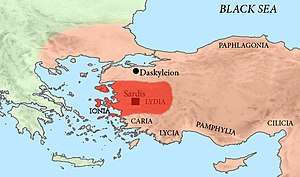Tiribazus
Tiribazus, Tiribazos or Teribazus (c.440 BC-370 BC) was an Achaemenid satrap of Western Armenia and later satrap of Lydia in western Anatolia.
Tiribazus | |
|---|---|
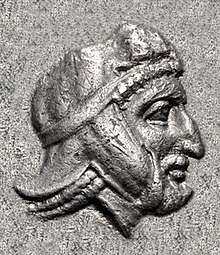 Portrait of Tiribazos wearing the Satrapal cap, from his coinage. | |
| Born | c.440 BC |
| Died | c.370 BC |
| Allegiance | |
| Rank | Satrap |
| Battles/wars | Corinthian War |
Satrap of Western Armenia
He was highly regarded by the Persian King Artaxerxes II, and when he was present, so Xenophon tells us, no one else had the honour of helping the sovereign to mount his horse.[1]
At the time of the retreat of the 10,000 in 401 BC, Tiribazus was satrap of Western Armenia.
Satrap of Lydia
He succeeded Tithraustes as satrap of Western Asia (Sardis). He was holding this office when, in 393 BC, Antalcidas was sent to negotiate, through him, a peace for Sparta with the Persian king.[2]
In 392 BC, while the Corinthian War was being contested amongst the Greek states, Tiribazus received envoys from the major belligerents of that war, and held a conference in which a proposal for ending the war was discussed. That discussion failed, but Tiribazus, convinced that Athens was becoming a threat to Persia in the Aegean, secretly provided funds to rebuild the Spartan fleet. When the Persian king Artaxerxes II learned of this, Tiribazus was removed from power and replaced by Struthas, who pursued an anti-Spartan policy.
However, five years later, in 387 BC, Tiribazus was again in power, and worked together with the Spartan general Antalcidas to rebuild the Spartan fleet as a threat to Athenian interests in the region. This action brought the Athenians and their allies to the negotiating table. Tiribazus represented Artaxerxes at the ensuing negotiations, which led to the Peace of Antalcidas.[3]
In 386 BC, he was appointed to command the Persian fleet against Evagoras, the king of Salamis in Cyprus, with the land forces being entrusted to the Persian satrap of Armenia, Orontes. They defeated Evagoras and lay siege to Salamis. However, in 385 BC Tiribazus was impeached by Orontes, and was recalled to court to answer for his conduct.
Tiribazus was detained in prison until the return of Artaxerxes from his expedition against the Cadusii. Before three judges, Tiribazus was able to have the charges against him dismissed, and he was honourably acquitted with the full support of King Artaxerxes, in consideration not only of his innocence in regard to the special charges, but also of the great services he had rendered to his master.
Tiribazus now stood higher than ever in the royal favour, and received a promise of the hand of Amestris, the king's daughter. Artaxerxes, however, reneged on this arrangement, and married Amestris himself.
When King Artaxerxes reneged on a pledge to Tiribazus once more, this time with respect to Atossa, the youngest of the king's princesses, Tiribazus could no longer remain loyal to the king and incited Darius, the son of Artaxerxes, to join him in a plot against the king's life.
Tiribazus' plans were betrayed to Artaxerxes by a eunuch, and the conspirators were found out. Tiribazus offered a desperate resistance to the guards who endeavored to arrest him, and was slain with a javelin.[2]
Coinage
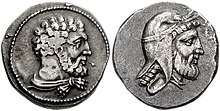 Coinage of Tiribazos. Satrap of Lydia, 388-380 BC
Coinage of Tiribazos. Satrap of Lydia, 388-380 BC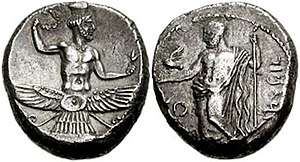 Coinage of Tiribazus, Satrap of Lydia, with Ahuramazda on the obverse. 388-380 BCE.
Coinage of Tiribazus, Satrap of Lydia, with Ahuramazda on the obverse. 388-380 BCE. Western Asia Satrap of the Achaemenid Period. Probably Tiribazos. Early 4th century BC.
Western Asia Satrap of the Achaemenid Period. Probably Tiribazos. Early 4th century BC.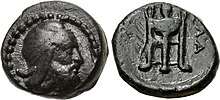 Coinage of Tiribazos. Klazomenai mint.
Coinage of Tiribazos. Klazomenai mint.
References
- Garsoïan, ‘The Emergence’, pp. 42-44; Xenophon, Anabasis, 4.4, 4.
- Smith, William. "TIRIBAZUS". Smith, Dictionary of Greek and Roman Biography and Mythology. Retrieved 2009-04-17.
- Fine, John V.A. The Ancient Greeks: A critical history (Harvard University Press, 1983) ISBN 0-674-03314-0
- Xenophon (1890s) [original 4th century BC]. . Translated by Henry Graham Dakyns – via Wikisource.
